Related Research Articles
Baron Cromwell is a title that has been created several times in the Peerage of England. The first creation, which was by writ, was for John de Cromwell in 1308. On his death, the barony became extinct. The second creation came in 1375 when Ralph de Cromwell was summoned by writ to Parliament as Lord Cromwell. His grandson, the third baron, served as Lord High Treasurer to King Henry VI. However, on his death in 1455 the barony fell into abeyance between his nieces Maude and Joan. On Joan's death in 1490 the abeyance was terminated in favour of Maude, the fourth holder. When she died childless in 1497 the peerage once again fell into abeyance, this time between the daughters of the first baron. The title remained in abeyance for over 400 years. However, in 1922 the Committee for Privileges of the House of Lords reported in favour of the petition for the termination of the abeyancy of Selina Frances Bewicke-Copley. She was the daughter of Sir Charles Watson Copley, 3rd Baronet, and one of the co-heirs of Maud, daughter of the first baron Cromwell. Selina died in 1923 and in July of the same year the abeyance was terminated in favour of her son Robert Godfrey Wolesley Bewicke-Copley, who became the fifth baron. He notably served as Lord Lieutenant of Leicestershire. As of 2010 the ancient barony is held by his grandson, the seventh baron, who succeeded his father in 1982. Having lost his seat in the House of Lords under the House of Lords Act 1999, in April 2014 he was elected at a hereditary peers' by-election as a Crossbencher.

Baron Carleton is a title that has been created three times in British history, once in the Peerage of Ireland and twice in the Peerage of Great Britain. The first creation came in the Peerage of England in 1626 when Sir Dudley Carleton was made Baron Carleton, of Imbercourt in the County of Surrey. He was made Viscount Dorchester two years later. See the article on him for more information on this creation. Dudley Carleton was the first cousin of Sir John Carleton, 1st Baronet.

Earl of Plymouth is a title that has been created three times: twice in the Peerage of England and once in the Peerage of the United Kingdom.
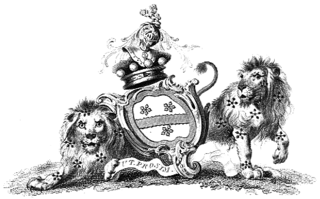
Baron Foley is a title that has been created twice in the Peerage of Great Britain, both times for members of the same family.

Baron Sheffield is a title that has been created four times: once in the Peerage of England, twice in the Peerage of Ireland, and once in the Peerage of the United Kingdom.

Baron St Helens is a title that has been created three times, once in the Peerage of Ireland and twice in the Peerage of the United Kingdom.

Baron Sudeley is a title that has been created thrice in British history, twice in the Peerage of England and once in the Peerage of the United Kingdom. The first creation came in the Peerage of England in 1299 when John de Sudeley was summoned to Parliament as Lord Sudeley. On the death of the third Baron in 1367 the title fell into abeyance. The abeyance was terminated in 1380 when Thomas Boteler, the fourth Baron, became sole heir. The sixth Baron was created Baron Sudeley by letters patent in 1441. He served as Lord High Treasurer from 1444 to 1447. On his death in 1473 the 1441 creation became extinct while the 1299 creation once again fell into abeyance.

Baron Milford is a title that has been created three times, once in the Peerage of Ireland and twice in the Peerage of the United Kingdom. All three creations have been for members of the same family. The first creation came in the Peerage of Ireland in 1776 when Sir Richard Philipps, 7th Baronet, of Picton Castle was made Baron Milford. However, this title became extinct on his death in 1823, while the baronetcy was passed on to a distant relative. The title was revived in the Peerage of the United Kingdom in 1847 when Sir Richard Philipps, 1st Baronet, of Picton Castle was created Baron Milford, of Picton Castle in the County of Pembroke. Born Richard Bulkeley Philipps Grant, he was the son of John Grant and Mary Philippa Artemisia, daughter of James Child and Mary Philippa Artemisia, daughter of Bulkeley Philipps, uncle of the first Baron of the first creation. He succeeded to the Philipps estates in 1823 and assumed the surname of Philipps the same year. In 1828 he was created a Baronet, of Picton Castle in the County of Pembroke, in the Baronetage of the United Kingdom. However, Lord Milford was childless and the titles became extinct on his death in 1857. He devised his estates to his half-brother Reverend James Henry Alexander Gwyther, who assumed the surname of Philipps. James's daughter Mary Philippa married Charles Edward Gregg Fisher, who assumed the surname of Philipps and was created a Baronet, of Picton, in 1887.

Baron Coleraine is a title that has been created three times, twice in the Peerage of Ireland and once in the Peerage of the United Kingdom.
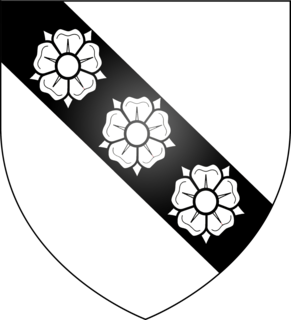
Baron Hunsdon is a title that has been created three times.

Earl of Worcester is a title that has been created five times in the Peerage of England.

Baron Sydney was a title that was created three times in British history. The title was later elevated twice into a viscounty, and from there, once more into an earldom.
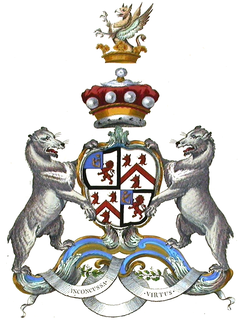
Baron Bingley is a title that has been created three times, twice in the Peerage of Great Britain and once in the Peerage of the United Kingdom.
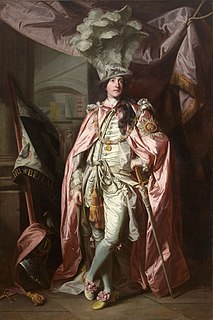
Earl of Bellomont, in the Kingdom of Ireland, was a title that was created three times in the Peerage of Ireland. The first creation came on 9 December 1680 when Charles Kirkhoven, 1st Baron Wotton, was made Earl of Bellomont. He had already been created Baron Wotton, of Wotton in the County of Kent, in the Peerage of England on 31 August 1650. He was childless and both titles became extinct on his death in 1683.
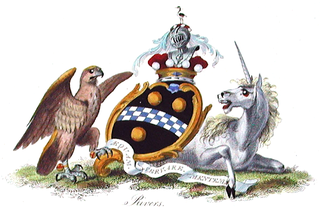
Baron Rivers was a title that was created four times in British history, twice in the Peerage of England, once in the Peerage of Great Britain and once in the Peerage of the United Kingdom.
Baron Montfort is a title that has been created twice in British history. The first creation came in the Peerage of England when John de Montfort was summoned to parliament on 23 June 1295. In 1367 the title either became extinct or fell into abeyance on the death of the third Baron. The second creation came in the Peerage of Great Britain in 1741 when Henry Bromley was made Lord Montfort, Baron of Horseheath, in the County of Cambridge. He had previously represented Cambridgeshire in Parliament, as had his father John Bromley and grandfather John Bromley. Lord Montfort was succeeded by his only son, the second Baronet. He sat as Member of Parliament for the city of Cambridge. The title became extinct on the death of his son, the third Baron, in 1851.
Baron Dover is a title that has been created three times, once in the Peerage of England, once in the Peerage of Great Britain and once in the Peerage of the United Kingdom. All three creations are now extinct.
Baron Holmes was a title that was created twice in the Peerage of Ireland. The first creation came on 11 September 1760 when the politician Thomas Holmes was made Baron Holmes, of Kilmallock in the County of Limerick. The title became extinct on his death on 21 July 1764. The second creation came on 6 November 1797 when Leonard Holmes was made Baron Holmes, of Kilmallock in the County of Limerick. He was the nephew of the first Baron of the 1760 creation. The title became extinct on his death on 18 January 1804.

Baron Langdale was a title that was created twice in British history. The first creation came in the Peerage of England on 4 February 1658 when the prominent royalist commander of the English Civil War, Sir Marmaduke Langdale, was made by Baron Langdale, of Holme. He had fought alongside Prince Rupert and the Marquess of Newcastle at the Battle of Marston Moor, prior to the war he was the High Sheriff of Yorkshire and in later life a Catholic convert. His son, the second Baron, was Governor of Kingston-upon-Hull. The title descended from father to son until the death of the fifth Baron in 1777. He had no heir as his only son had died as an infant and the title became extinct on his death in 1777. The territorial designation "of Holme" refers to the family's chief seat, Holme Hall in the parish of Holme-on-Spalding-Moor, Yorkshire. The ancient surname of "Langdale" refers to the manor of Langdale in the hundred of Pickering in the County of York which Marmaduke's ancestors held as their seat from before the reign of King John (1199-1216).
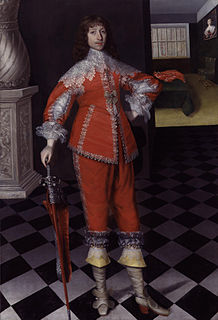
Baron Belasyse was a title that was created twice in the Peerage of England. The first creation came on 27 January 1645 when the Honourable John Belasyse was made Baron Belasyse of Worlaby in the County of Lincoln. He was the second son of Thomas Belasyse, 1st Viscount Fauconberg, the younger brother of the Honourable Henry Belasyse and the uncle of Thomas Belasyse, 1st Earl Fauconberg. He was succeeded by his grandson, Henry, the second Baron, the son of Sir Henry Belasyse, who was killed in a duel in 1667. The title became extinct when the second Baron died childless in 1691.